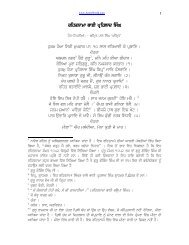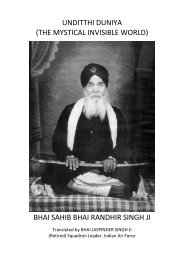Guru Gobind Singh's Death at Nanded Examination of - Vidhia.com
Guru Gobind Singh's Death at Nanded Examination of - Vidhia.com
Guru Gobind Singh's Death at Nanded Examination of - Vidhia.com
Create successful ePaper yourself
Turn your PDF publications into a flip-book with our unique Google optimized e-Paper software.
34 AN EXAMINATION OF SUCCESSION THEORIES<br />
This is a simple and straigthforward account <strong>of</strong> the<br />
de<strong>at</strong>h <strong>of</strong> <strong>Guru</strong> <strong>Gobind</strong> Singh with no mystery or embellishment<br />
enshrouding it. And it agrees in all its essentials with<br />
the contemporary and the earliest known accounts.<br />
According to Vir Singh Ball, the author <strong>of</strong> the Singh<br />
Sqgar <strong>com</strong>pleted in January 1828, <strong>Guru</strong> <strong>Gobind</strong> Singh died<br />
<strong>at</strong> <strong>Nanded</strong> due to excessive bleeding after he pulled the stiff<br />
bow received from Lahore. In a poetical vein the author<br />
tells us th<strong>at</strong>, like <strong>Guru</strong> Nanak, <strong>Guru</strong> <strong>Gobind</strong> Singh also disappeared<br />
from under the sheet th<strong>at</strong> was covering his dead<br />
body in the presence <strong>of</strong> a multitude <strong>of</strong> Sikhs. His light, he<br />
says, blended with the Light <strong>of</strong> God and he went to heaven,<br />
the abode <strong>of</strong> the All-Truth—the Sach-khcmd—and his clothes,<br />
like those <strong>of</strong> <strong>Guru</strong> Nanak, were crem<strong>at</strong>ed according to the<br />
prevalent rites. He makes no mention <strong>of</strong> any wood-cutter,<br />
sadhu or anyone else seeing him afterwards. Evidently, Vir<br />
Singh had no belief in the after-de<strong>at</strong>h legends associ<strong>at</strong>ed with<br />
<strong>Guru</strong> <strong>Gobind</strong> Singh. For him, de<strong>at</strong>h was the end <strong>of</strong> the<br />
<strong>Guru</strong>'s life like th<strong>at</strong> <strong>of</strong> the first <strong>Guru</strong>. [Appendix VIII. J<br />
The Prachin Panth Prakash by Bhangu R<strong>at</strong>an Singh<br />
Shahid, <strong>com</strong>pleted in 1841 A.D., is mostly devoted to the<br />
history <strong>of</strong> the Sikhs after the de<strong>at</strong>h <strong>of</strong> <strong>Guru</strong> <strong>Gobind</strong> Singh to<br />
the rise and development <strong>of</strong> Sikh political power by the third<br />
quarter <strong>of</strong> the eighteenth century. Except for a brief account<br />
<strong>of</strong> the <strong>Guru</strong> period, it primarily deals with those events<br />
wherein the author's own ancestors played a prominent part.<br />
Since the author confines the account <strong>of</strong> the <strong>Guru</strong> <strong>at</strong><br />
<strong>Nanded</strong> only to his visit to the hermitage <strong>of</strong> Bairagi Madho<br />
Das and his conversion to Sikhism and departure for the<br />
Panjab, the Prachin Panth Prakash contains no reference to<br />
the <strong>Guru</strong>'s last <strong>com</strong>mandment and message about future<br />
<strong>Guru</strong>ship.<br />
The Gur-pr<strong>at</strong>ap Suraj Granth, popularly known as the<br />
Suraj Prakash, by Bhai Santokh Singh, <strong>com</strong>pleted in 1900<br />
Bikrami, 1843 A.D., is one <strong>of</strong> the gre<strong>at</strong>est epical <strong>com</strong>positions<br />
<strong>of</strong> India. It is written on the lines <strong>of</strong> Rishi Valmiki's<br />
Ramayana which the poet had transl<strong>at</strong>ed earlier in 1891<br />
GURU GOBIND SINGH S DEATH AT NANDED<br />
Bikrami, 1834 A.D. The Suraj Prakash deals with the lives<br />
<strong>of</strong> the Sikh <strong>Guru</strong>s and may be classed as hagiological liter<strong>at</strong>ure<br />
wherein lives and legends are so closely interwoven th<strong>at</strong><br />
they cannot be easily separ<strong>at</strong>ed. And therein lies the beauty<br />
<strong>of</strong> the art <strong>of</strong> poetry where prominence is given to imagin<strong>at</strong>ion<br />
and personal idiosyncrasy and not to impartial transcription<br />
<strong>of</strong> historical realities. History is the faithful record <strong>of</strong> events<br />
as they actually took place. It has no place for legends and<br />
myths which figure so prominently in the Suraj Prakash, They<br />
are mostly borrowed from earlier hagiographs and freely<br />
expanded by Bhai Santokh Singh with his embellishments in<br />
which he hardly has a parallel in the Braj poetry. As such,<br />
his account <strong>of</strong> the last days <strong>of</strong> <strong>Guru</strong> <strong>Gobind</strong> Singh cannot be<br />
accepted as truly historical in all its details.<br />
Some time before his de<strong>at</strong>h, <strong>Guru</strong> <strong>Gobind</strong> Singh is<br />
said to have declared th<strong>at</strong> he had transferred his Light to the<br />
Khalsa—th<strong>at</strong> the <strong>Guru</strong> was Khalsa and the Khalsa was the<br />
<strong>Guru</strong>. The <strong>Guru</strong>, fully dressed and armed, then walked to the<br />
place <strong>of</strong> crem<strong>at</strong>ion and mounted the pyre. But the flaming<br />
fire did not touch'.his body. He then, like the supern<strong>at</strong>ural<br />
yogis <strong>of</strong> old, produced fire ( Yog-agni) from within himself and<br />
set out for heaven where he was wel<strong>com</strong>ed and received by all<br />
the ancient Hindu gods. This happened, says the poet,<br />
onK<strong>at</strong>ik Sudi 5, 1765 Bikrami, October 6-7, 1708 A.D.<br />
After the departure <strong>of</strong> the <strong>Guru</strong> for heaven, the gre<strong>at</strong><br />
poet also narr<strong>at</strong>es the stories <strong>of</strong> his having been seen in the<br />
neighbouring jungle by a wood-cutter and a sadhii. In doing<br />
so he has only repe<strong>at</strong>ed the legends <strong>of</strong> the earlier writers like<br />
Koer Singh and Sukha Singh.<br />
It will be interesting to note here th<strong>at</strong>, unlike, all other<br />
writers on the subject, the author <strong>of</strong> the Suraj Prakash mentions<br />
the install<strong>at</strong>ion <strong>of</strong> the Holy BorJk, the <strong>Guru</strong> Granth Sahib,<br />
as <strong>Guru</strong> during the last days <strong>of</strong> <strong>Guru</strong> Har Krishan as also<br />
<strong>of</strong> the Bdbd <strong>of</strong> Bakala. [Rds 10, Ansu 51, No. 26-29; Ansu 55,<br />
No. 20-23.]<br />
Munshi Sant Singh, a vakil <strong>of</strong> the Bedis, wrote an<br />
account <strong>of</strong> the Bedi family <strong>of</strong> Una under the title <strong>of</strong> the<br />
35




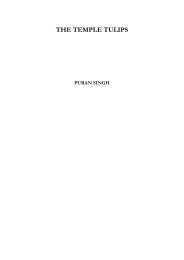
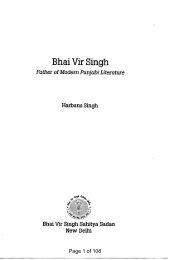

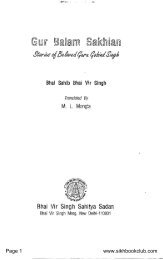
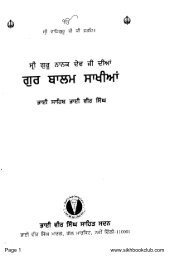
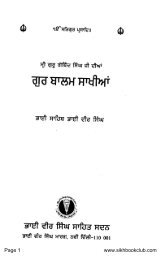
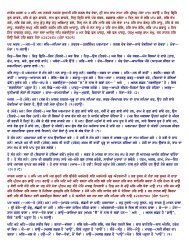
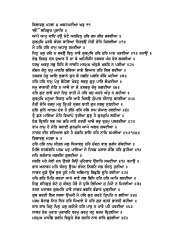

![cOpeI ] hmrI kro hwQ dY r~Cw ] pUrn hoie ic~q kI ie ... - Vidhia.com](https://img.yumpu.com/12240258/1/190x245/copei-hmri-kro-hwq-dy-rcw-purn-hoie-icq-ki-ie-vidhiacom.jpg?quality=85)
